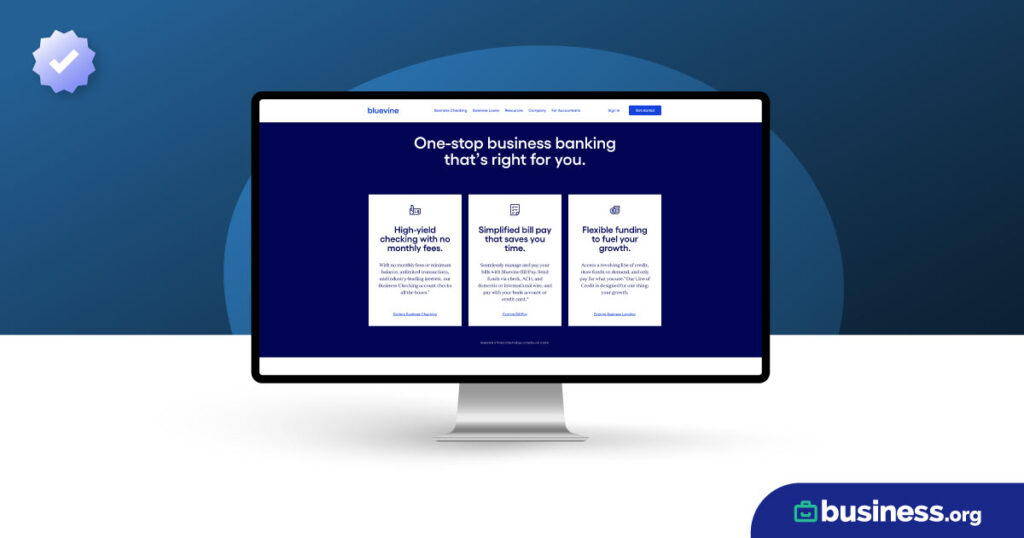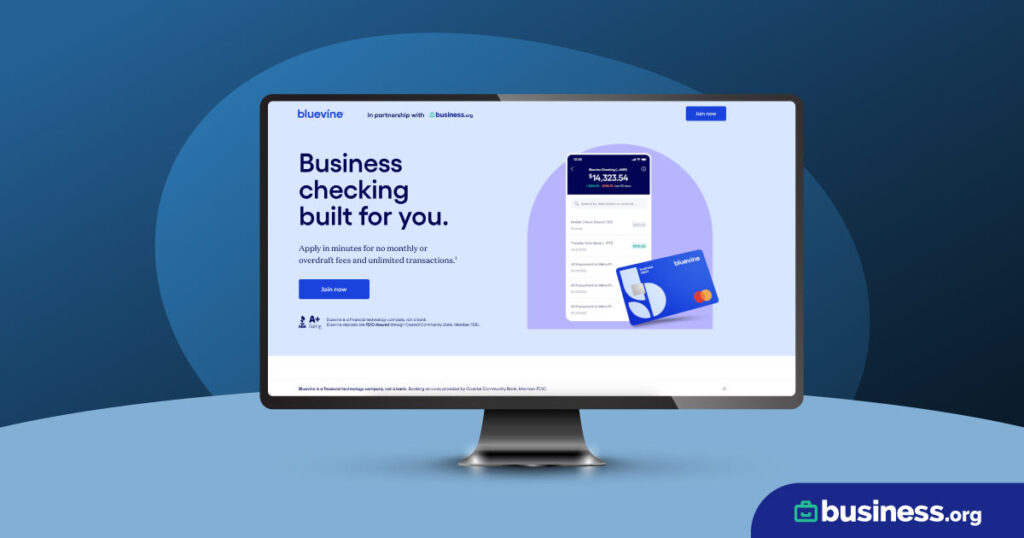We are committed to sharing unbiased reviews. Some of the links on our site are from our partners who compensate us. Read our editorial guidelines and advertising disclosure.
Compare Bluevine vs. Chase Business Checking 2025
Data as of 12/15/22. Offers and availability may vary by location and are subject to change.
We used our bank scoring system to grade both Bluevine and Chase on quite a few factors, from their account options to their pricing to their customer service. In this article, we’ll use our objective comparisons to point out what each bank does well―and what it doesn’t.
Bluevine offers a better online banking experience for most small businesses (thanks to its lack of fees and widespread availability). Some cash-heavy businesses may prefer in-person banking with Chase, though. We’ll tell you about all that―and more―as we compare these two banks.
- : Bluevine
- : Bluevine
- : Chase
- : Bluevine
- : Chase
- : Bluevine
Bluevine vs. Chase at a Glance
Data as of 12/15/22. Offers and availability may vary by location and are subject to change.
Before we get too into the weeds, let’s talk about the biggest difference between Bluevine and Chase: what kind of banks they are.
Chase Bank is a traditional bank, meaning it has brick-and-mortar branches where you can (and sometimes have to) do your banking. Because this is the 21st century, Chase does offer plenty of options for online banking and mobile banking. But there may be times when you need to visit a physical branch (like to open certain high-tier checking accounts or to apply for business financing).
Bluevine, on the other hand, is an online bank. It has no physical branches―at all―so you’ll do pretty much all your banking on your computer or phone. The one exception? If you need to make a cash deposit. You’ll have to visit a Green Dot location if you want to deposit cash into your business checking account.
So with that key difference in mind, let’s look at how Bluevine and Chase compare in some of the most important areas.
By signing up I agree to the Terms of Use and Privacy Policy.
Widest Availability: Bluevine
First things first, more businesses can use Bluevine than can use Chase.
That’s because Chase, as a traditional bank, only does business in 48 states. That's more states than Chase used to operate in, but it's not up to Bluevine's perfect 50.
As an online bank, Bluevine doesn’t have any physical branches. Instead, like we said, it’s available in all 50 states (as long as you have an internet connection). So no matter where you live, Bluevine offers business checking in your area.
Bluevine also has a bigger ATM network. While Chase has a decent network of 16,000 ATMs, Bluevine more than doubles that with its network of 37,000 ATMs.
Likewise, as we already mentioned, Bluevine lets you deposit cash at Green Dot locations―which are usually retail stores like Walmart or Walgreens. That means you can deposit cash into your Bluevine checking account at 90,000 Green Dot locations across the country, while Chase limits you to its 4,700 branch locations.
Put simply, Bluevine is way more accessible than Chase.
Best Pricing: Bluevine
Even if Chase is available in your area, we think you’ll be impressed by Bluevine’s business bank account costs (or the lack thereof).
Bluevine vs. Chase Checking Account Pricing
Data as of 12/15/22. Offers and availability may vary by location and are subject to change.
Bluevine business checking accounts don’t come with most of the fees you expect. You don’t have to pay a monthly service fee (ever) or transaction fees, for example. You don’t even have to worry about overdraft fees. And as the cherry on top, Bluevine gives you two free checkbooks when you sign up.
Then there’s Chase, which charges all the typical checking account fees. You’ll pay a monthly service fee (though, to be fair, some accounts give you options for waiving that fee), transaction fees (after you make a small number of free transactions), cash deposit fees (after you max out your free cash deposits for the month), overdraft fees, and so on.
Again, Chase doesn’t have to cost a lot. If you maintain a high account balance and make few transactions and cash deposits, you may be able to waive your monthly fee and avoid transaction fees and cash deposit fees.
But given that your Bluevine business checking account comes with hardly any fees at all―no matter how you use it―it’s clear that Bluevine offers the better deal, price-wise.
Most Account Options: Chase
Chase does have a big advantage over Bluevine: It has way more account options.
At Bluevine, you can get its basic business checking account. It offers five sub-accounts to help you divide up your funds better, but that’s it. Luckily, it’s a good business account. But still, you have just the one bank account option.
Chase, on the other hand, gives you three business checking choices:
- Chase Business Complete Banking
- Chase Performance Business Checking
- Chase Platinum Business Checking
Plus, Chase offers personal checking and business savings account options too. (Not to mention business credit cards, merchant services, and more.)
So whether you’re a brand-new business owner looking for a cheap account or you’ve got a big business that needs feature-rich checking, Chase has a business account for you.
You’ll have to decide for yourself whether any Chase business accounts actually offer a better deal than Bluevine’s sole business checking account.
In terms of sheer numbers, though, Chase offers more business checking account choices than Bluevine.
Highest Interest Rate: Bluevine
You may have noticed that Chase Bank offers a couple business interest checking accounts. These accounts let you earn interest on your account balance, which make them tempting for many business owners.
So it’s worth noting that Bluevine business checking can also earn interest―and we have reason to believe it earns a better interest rate.
Bluevine accounts earn 2.0% APY (annual percentage yield) on balances up to $250,000. That’s a fantastic rate―the highest we’ve seen from any business bank, in fact. Plus, it applies to sub-accounts too.
You’ll have to do one of two things to earn that interest rate:
- Spend $500 with your Bluevine business debit card each month
- Get $2,500 in customer payments in your Bluevine account each month (through ACH, wire transfer, check deposit, or payment processing)
That’s a bummer, but it’s also pretty doable for many small-business owners. And again, the 2.0% interest rate is unbeatable.
But how does that compare to Chase? Well, Chase doesn’t publish interest rates on its business checking accounts―not a good sign. But based on the rates we’ve seen for its savings accounts, we don’t expect Chase business accounts to earn much interest. And don’t forget, you’ll have to pay all kinds of account fees (including unwaivable monthly fees) to use one of Chase’s interest-bearing checking accounts.
In other words, if you want to earn a great interest rate, we suggest going with Bluevine.
Most Branches: Chase
As you can see, Bluevine has quite a few advantages. But Chase does have more upsides we want to make clear―and that’s the number of branches.
Like we mentioned earlier, Chase has 4,700 branches, while Bluevine has 0 branches.
For some small-business owners, that doesn’t matter much. But if you have a particularly cash-heavy business, for example, you might prefer to deposit your funds at an actual bank with an actual bank teller. Or you might just like the feeling of doing business in a branch you know with humans who can help you (rather than fiddling with a buggy app or a website).
Simply put, if you’re the kind of business owner that prefers a brick-and-mortar business banking experience, then understand that Chase has (way, way) more branches than Bluevine.
Best Reputation: Bluevine
At this point, you might still think Chase sounds okay. But we want to be very clear about this last thing: Chase has a very, very bad reputation.
Take customer reviews on Trustpilot. Bluevine earns a pretty respectable 4.3 out of 5, while Chase earns a measly 1.3 out of 5.1, 2
So why the difference? Well, Chase has a history of acting in scammy ways. As we detail in our Chase business banking review, Chase has been accused of quite a few bad things in recent years:
- Charging customers for services they didn’t buy
- Discriminating against customers of certain races
- Processing transactions in a way to maximize overdraft fees
And that’s just the tip of a very large iceberg. Likewise, its Trustpilot page is filled with reviews from customers claiming Chase didn’t honor bonus offers, wouldn’t help with fraud cases, lost payments, and caused other customer service disasters.
Seriously, Chase’s reputation is bad enough that we don’t recommend it. If you really do want to go with a physical bank, we recommend other banks (like Huntington Bank, TD Bank, Citizens Bank, and others) or your local credit union.
Or, of course, you can go with Bluevine. It may not have perfect reviews, but Bluevine has a much better reputation than Chase does. For a little bit more information on Bluevine, read our more in-depth review.
The Takeaway
For most business owners, Bluevine offers a better business checking experience than Chase. Bluevine is more widely available, has lower account fees, offers higher rates on business interest checking, and has a decent reputation.
Some small-business owners might still be interested in Chase Bank, due to its many business account options and its number of branches. But with its horrible reputation, we recommend choosing other banks or credit unions over Chase―even if you don’t go with Bluevine.
Want to explore some more business checking options? Check out our rankings of the best banks for small-business checking.
Related Reading
Bluevine vs. Chase FAQ
Yes, Bluevine banking and Bluevine lending are legitimate. Bluevine has thousands of very positive reviews from customers on Trustpilot.1
Most banks are better than Chase Bank, honestly.
If you want an online bank, we specifically recommend Small Business Bank, Bluevine, and LendingClub Bank (which you can read more about in our guide to the best online business bank accounts).
If you prefer traditional banks, the best option will depend on where your business is located. But generally speaking, we like KeyBank, Citizens Bank, TD Bank, Huntington Bank, and SunTrust―all of which we review in our rankings of the best banks for small business.
Bluevine uses two different banks. Bluevine uses Coastal Community Bank to power its business checking accounts, and it uses Celtic Bank to offer its business lines of credit.
Disclaimer
At Business.org, our research is meant to offer general product and service recommendations. We don't guarantee that our suggestions will work best for each individual or business, so consider your unique needs when choosing products and services.





